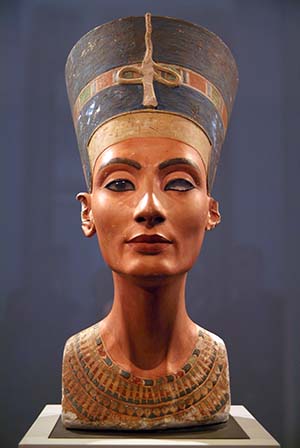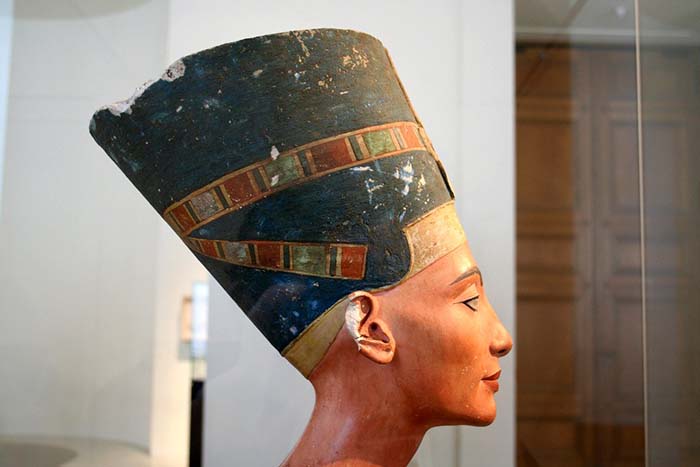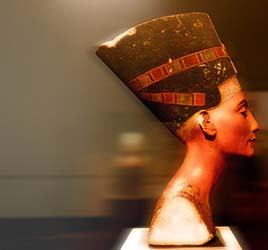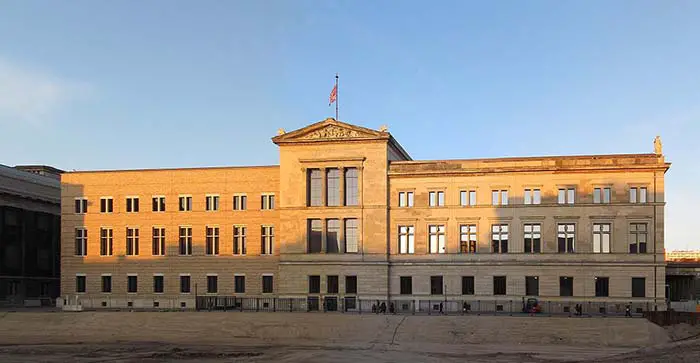Nefertiti's Bust
Nefertiti: Wife of Pharaoh Akhenaten and Queen of Egypt. Known for her beauty, many works depicting this ancient and mysterious monarch still exist. The most remarkable discovery thus far is none other than the world-renowned Nefertiti's Bust.
Discovery
In December 1912, the German archaeologist Ludwig Borchardt was in charge of a dig. It was on the banks of the Nile River that an Egyptian worker stumbled across the rubble of a structure. The structure was the studio and home of celebrated court sculptor, Thutmose.
Among the debris, the team uncovered an astounding artifact. It was upside down and embedded in the floor of the workshop. Borchardt wrote, "The tools were put aside, and the hands were now used … It took a considerable amount of time until the whole piece was completely freed from all the dirt and rubble."

© Giovanni - Bust of Nefertiti
Description
Borchardt referred to the bust in his journal as "[..] the most lively piece of Egyptian art."
The elegantly carved statue illustrates Nefertiti's delicate features and swanlike neck with expert precision.
The paint is detailed, enhancing her beauty in various shades of red, green, blue, gold, and black, and is intact and in excellent condition.
Nefertiti's bust details both her delicate features and a finely-detailed necklace and lavish headdress. One eye is inlaid with wax and crystal, though due to unknown circumstances. Unfortunately, Thutmose was unable to finish the second eye; she is alluring, nonetheless.
Analysis
Years of examination and technological advances have helped analyze the make-up of Nefertiti's Bust. Studies conclude she consists of layers of gypsum, stucco plaster, and a limestone core. The use of stucco plaster enabled Thutmose to craft her headdress, face, and neck. The plaster also lent to the symmetry of the sculpture. In fact, the lines of her face and headdress form a perfect triangle.
The age of this incredible artwork is approximately 3,300 years. Due to the unfinished nature of the bust, many believe that Thutmose intended it as a 3D model for future portraits and sculptures of the Queen.

© Luís Estrela - Side View of Nefertiti's Bust
Controversies
Nefertiti's Bust has been the source of much controversy since its discovery, and not just between Egypt and Germany.
Upon its discovery, it appears that Borchardt "fudged the facts", so to speak. A 1924 document alleges that Borchardt made it a point to downplay the significance of his discovery. He did so by stating that it was made of gypsum and not limestone and stucco. The idea was that the bust could remain in German possession. The bust has been a source of pride for Germany for over a century. Even Hitler had a deep fondness for the statue, having said, "I will never relinquish the head of the Queen."
Another controversy came to light in 2009, when two historians, Erdogan Ercivan and Henri Stierlin, claimed that it was a 20th century work. They allege that an unknown source created it as a means to test pigments and that Borchardt claimed it was authentic so as not to shame Prince Johann Georg.
To this day, the bust remains a sore subject in regards to diplomacy between Germany and Egypt. Chief of the Egyptian Supreme Council of Antiquities, Zahi Hawass, has attempted to request the bust's return to Egypt, but curators at Berlin's Egyptian Museum vehemently assert that it is too fragile and may sustain damage if moved.

© Claudio Desteghene - Nefertiti Bust
Significance
Nefertiti's bust has come to signify many things to many people.
To some, the bust denotes a point in Egyptian history during which a temporary switch to monotheism took place and changed the cultural ideals of beauty.
To others, the statue represents the mystique of femininity and the ability for women to rise to power, even during ancient times, making Queen Nefertiti a worldwide symbol for feminism. To many, the bust is merely a fascinating glimpse into the Egypt of the past.
Display
When Nefertiti's bust spent the initial years after its discovery in the private collection of philanthropist James Simon, though he eventually donated his collections to various museums in Berlin and had been on public display since 1923.
During WWII, Nazi's hid the bust in a salt mine so Hitler could include it in his museum collection. However; the museum was damaged significantly during the war, and Nefertiti's bust now sits in a place of honor in the Neues Museum in Berlin.

© Gryffindor - Neues Museum, Berlin
Facts
- The team of Ludwig Borchardt, funded by James Simon, discovered the bust on December 6, 1912.
- The team uncovered the sculpture among the ruins of the workshop of Thutmose.
- The bust is a 14th-century artifact and is thought to be approximately 3,300 years old.
- The bust was first presented for public display in Berlin in 1923.
- Borchardt's dishonesty regarding the discovery enabled Germany to maintain possession of the bust.
- The sculpture consists of a limestone core, layers of stucco, and gypsum.
- A source of much controversy, the bust is still a cause for discourse between Egypt and Germany.
- Nefertiti's bust remains on display in Berlin and attracts nearly a half a million visitors each year.
- So far, Germany has rejected any and all attempts to return Nefertiti's Bust to Egypt.
- There is currently an ongoing campaign on behalf of the Egyptian Supreme Council of Antiquities to bring the bust back to Egypt, even if for a temporary loan.
